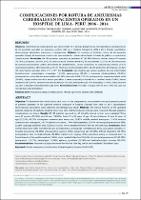Complicaciones por rotura de aneurismas cerebrales en pacientes operados en un hospital de Lima - Perú, 2006 – 2014
Related Resource(s)
https://revistas.urp.edu.pe/index.php/RFMH/article/view/1266Date
2018Author(s)
Coasaca-Torres, Juan Amilcar
Loayza-Alarico, Manuel Jesus
Navarrete-Mejia, Pedro Javier
Metadata
Show full item recordAlternate title
Complications for breathing cerebral aneurysms in patients operated in a hospital of Lima- Peru. 2006 - 2014
Abstract
Objetivos: Determinar las complicaciones que se presentan en el periodo preoperatorio, intraoperatorio y postoperatorio de los pacientes operados de aneurisma cerebral roto en el Hospital Sabogal de 2006 a 2014. Estudio cuantitativo, observacional, descriptivo, transversal y retrospectivo. Métodos: Se revisaron las historias clínicas de los pacientes operados (clipaje) de aneurisma cerebral roto, que reunían los criterios de inclusión. A través de gráficos, se muestra las complicaciones. Resultados: De 109 pacientes operados, se evaluaron 67 (61.46%) historias clínicas. Fueron 47 mujeres (70.14%) y 20 varones (29.85%), de 22 a 82 años de edad, 35 tenìan entre 45 y 65 años de edad (52.23%), 49.25% aneurismas de comunicante posterior, 29.85% aneurismas de cerebral media, 13.43% aneurismas de comunicante anterior, 24.37% vasoespasmo global, 7.46% hidrocefalia, 50.74% neumonía intrahospitalaria (NIH), 22.38% problemas del lenguaje y 35.82% (24 casos) fueron operados entre el 4to y 10mo día. Conclusión: Más mujeres que varones padecen de esta enfermedad. Complicaciones: prequirúrgico: resangrado (13.43%), vasoespasmo (22.38% ), neumonía intrahospitalaria (10.44%); intraoperatorio: rotura del saco aneurismático (31.34%), disección difícil (53.73%); postoperatorio: isquemia cerebral tardía (26.86%), clipaje inadvertido de la arteria pericallosa o rama temporal y/o frontal de la cerebral media (7.46%), infarto cerebral distal (10.44%), neumonía intrahospitalaria 29 (43.28%), hemiparesia (25.37%), hemiplejia (11.94%), afasia, disartria (22.38%) y desorden hidroelectrolítico (85.07%). Recomendaciones: Proceder a cirugía entre el 4to y 10mo día, que son considerados días “prohibidos”. Objective: To determine the complications that occur in the preoperative, intraoperative and postoperative period of patients operated on for ruptured cerebral aneurysm in hospital Sabogal from 2006 to 2014. Quantitative, observational, descriptive, cross-sectional and retrospective study. Methods: The clinical histories of the operated patients (clipping) of ruptured cerebral aneurysm, who met the inclusion criteria, were reviewed. Through graphics, complications are shown. Results: Of 109 patients operated on, 67 (61.46%) clinical records were evaluated. There were 47 women (70.14%) and 20 men (29.85%), from 22 to 82 years of age, 35 were between 45 and 65 years of age (52.23%), 49.25% subsequent communicator aneurysms, 29.85% middle cerebral aneurysms, 13.43% anterior communicator aneurysms, 24.37% global vasospasm, 7.46% hydrocephalus, 50.74% intrahospital pneumonia (NIH), 22.38% language problems and 35.82% (24 cases) were operated between the 4th and 10th day. Conclusion: More women than men suffer from this disease. Complications: presurgical: rebleeding (13.43%), vasospasm (22.38%), in-hospital pneumonia (10.44%); intraoperative: rupture of the aneurysmal sac (31.34%), difficult dissection (53.73%); postoperative: late cerebral ischemia (26.86%), inadvertent clipping of the pericallose artery or temporal and / or frontal branch of the middle cerebral (7.46%), distal cerebral infarction (10.44%), intrahospital pneumonia 29 (43.28%), hemiparesis ( 25.37%), hemiplegia (11.94%), aphasia, dysarthria (22.38%) and hydroelectrolytic disorder (85.07%). Recommendation: Proceed to surgery between the 4th and 10th day, which are considered "forbidden" days.
Collections
- Artículos científicos [890]






